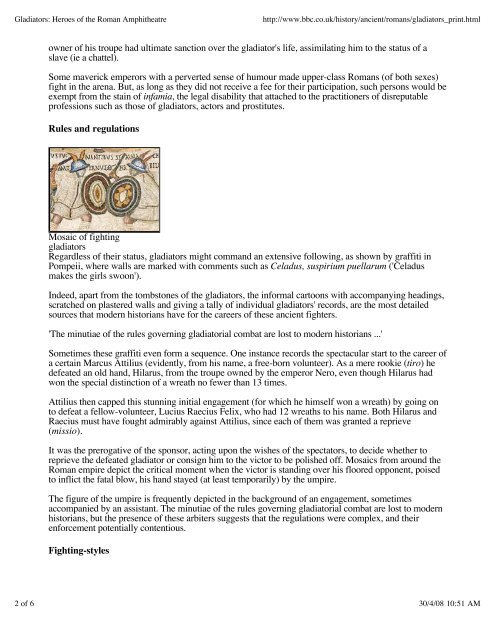Gladiators: Heroes of the Roman Amphitheatre
Gladiators: Heroes of the Roman Amphitheatre
Gladiators: Heroes of the Roman Amphitheatre
You also want an ePaper? Increase the reach of your titles
YUMPU automatically turns print PDFs into web optimized ePapers that Google loves.
<strong>Gladiators</strong>: <strong>Heroes</strong> <strong>of</strong> <strong>the</strong> <strong>Roman</strong> Amphi<strong>the</strong>atre http://www.bbc.co.uk/history/ancient/romans/gladiators_print.html<br />
owner <strong>of</strong> his troupe had ultimate sanction over <strong>the</strong> gladiator's life, assimilating him to <strong>the</strong> status <strong>of</strong> a<br />
slave (ie a chattel).<br />
Some maverick emperors with a perverted sense <strong>of</strong> humour made upper-class <strong>Roman</strong>s (<strong>of</strong> both sexes)<br />
fight in <strong>the</strong> arena. But, as long as <strong>the</strong>y did not receive a fee for <strong>the</strong>ir participation, such persons would be<br />
exempt from <strong>the</strong> stain <strong>of</strong> infamia, <strong>the</strong> legal disability that attached to <strong>the</strong> practitioners <strong>of</strong> disreputable<br />
pr<strong>of</strong>essions such as those <strong>of</strong> gladiators, actors and prostitutes.<br />
Rules and regulations<br />
Mosaic <strong>of</strong> fighting<br />
gladiators<br />
Regardless <strong>of</strong> <strong>the</strong>ir status, gladiators might command an extensive following, as shown by graffiti in<br />
Pompeii, where walls are marked with comments such as Celadus, suspirium puellarum ('Celadus<br />
makes <strong>the</strong> girls swoon').<br />
Indeed, apart from <strong>the</strong> tombstones <strong>of</strong> <strong>the</strong> gladiators, <strong>the</strong> informal cartoons with accompanying headings,<br />
scratched on plastered walls and giving a tally <strong>of</strong> individual gladiators' records, are <strong>the</strong> most detailed<br />
sources that modern historians have for <strong>the</strong> careers <strong>of</strong> <strong>the</strong>se ancient fighters.<br />
'The minutiae <strong>of</strong> <strong>the</strong> rules governing gladiatorial combat are lost to modern historians ...'<br />
Sometimes <strong>the</strong>se graffiti even form a sequence. One instance records <strong>the</strong> spectacular start to <strong>the</strong> career <strong>of</strong><br />
a certain Marcus Attilius (evidently, from his name, a free-born volunteer). As a mere rookie (tiro) he<br />
defeated an old hand, Hilarus, from <strong>the</strong> troupe owned by <strong>the</strong> emperor Nero, even though Hilarus had<br />
won <strong>the</strong> special distinction <strong>of</strong> a wreath no fewer than 13 times.<br />
Attilius <strong>the</strong>n capped this stunning initial engagement (for which he himself won a wreath) by going on<br />
to defeat a fellow-volunteer, Lucius Raecius Felix, who had 12 wreaths to his name. Both Hilarus and<br />
Raecius must have fought admirably against Attilius, since each <strong>of</strong> <strong>the</strong>m was granted a reprieve<br />
(missio).<br />
It was <strong>the</strong> prerogative <strong>of</strong> <strong>the</strong> sponsor, acting upon <strong>the</strong> wishes <strong>of</strong> <strong>the</strong> spectators, to decide whe<strong>the</strong>r to<br />
reprieve <strong>the</strong> defeated gladiator or consign him to <strong>the</strong> victor to be polished <strong>of</strong>f. Mosaics from around <strong>the</strong><br />
<strong>Roman</strong> empire depict <strong>the</strong> critical moment when <strong>the</strong> victor is standing over his floored opponent, poised<br />
to inflict <strong>the</strong> fatal blow, his hand stayed (at least temporarily) by <strong>the</strong> umpire.<br />
The figure <strong>of</strong> <strong>the</strong> umpire is frequently depicted in <strong>the</strong> background <strong>of</strong> an engagement, sometimes<br />
accompanied by an assistant. The minutiae <strong>of</strong> <strong>the</strong> rules governing gladiatorial combat are lost to modern<br />
historians, but <strong>the</strong> presence <strong>of</strong> <strong>the</strong>se arbiters suggests that <strong>the</strong> regulations were complex, and <strong>the</strong>ir<br />
enforcement potentially contentious.<br />
Fighting-styles<br />
2 <strong>of</strong> 6 30/4/08 10:51 AM







![alumni e-mail addresses by classes - word[3]](https://img.yumpu.com/13381322/1/190x245/alumni-e-mail-addresses-by-classes-word3.jpg?quality=85)








